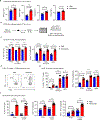ARTC2.2/P2RX7 Signaling during Cell Isolation Distorts Function and Quantification of Tissue-Resident CD8+ T Cell and Invariant NKT Subsets
- PMID: 30777922
- PMCID: PMC6424602
- DOI: 10.4049/jimmunol.1801613
ARTC2.2/P2RX7 Signaling during Cell Isolation Distorts Function and Quantification of Tissue-Resident CD8+ T Cell and Invariant NKT Subsets
Abstract
Peripheral invariant NKT cells (iNKT) and CD8+ tissue-resident memory T cells (TRM) express high levels of the extracellular ATP receptor P2RX7 in mice. High extracellular ATP concentrations or NAD-mediated P2RX7 ribosylation by the enzyme ARTC2.2 can induce P2RX7 pore formation and cell death. Because both ATP and NAD are released during tissue preparation for analysis, cell death through these pathways may compromise the analysis of iNKT and CD8+ TRM Indeed, ARTC2.2 blockade enhanced recovery of viable liver iNKT and TRM The expression of ARTC2.2 and P2RX7 on distinct iNKT subsets and TRM is unclear, however, as is the impact of recovery from other nonlymphoid sites. In this study, we performed a comprehensive analysis of ARTC2.2 and P2RX7 expression in iNKT and CD8+ T cells in diverse tissues, at steady-state and after viral infection. NKT1 cells and CD8+ TRM express high levels of both ARTC2.2 and P2RX7 compared with NKT2, NKT17, and CD8+ circulating memory subsets. Using nanobody-mediated ARTC2.2 antagonism, we showed that ARTC2.2 blockade enhanced NKT1 and TRM recovery from nonlymphoid tissues during cell preparation. Moreover, blockade of this pathway was essential to preserve functionality, viability, and proliferation of both populations. We also showed that short-term direct P2RX7 blockade enhanced recovery of TRM, although to a lesser degree. In summary, our data show that short-term in vivo blockade of the ARTC2.2/P2RX7 axis permits much improved flow cytometry-based phenotyping and enumeration of murine iNKT and TRM from nonlymphoid tissues, and it represents a crucial step for functional studies of these populations.
Copyright © 2019 by The American Association of Immunologists, Inc.
Figures






References
-
- Scheuplein F, Schwarz N, Adriouch S, Krebs C, Bannas P, Rissiek B, Seman M, Haag F, and Koch-Nolte F. 2009. NAD+ and ATP released from injured cells induce P2X7-dependent shedding of CD62L and externalization of phosphatidylserine by murine T cells. J Immunol 182: 2898–2908. - PubMed
-
- Di Virgilio F, Dal Ben D, Sarti AC, Giuliani AL, and Falzoni S. 2017. The P2X7 Receptor in Infection and Inflammation. Immunity 47: 15–31. - PubMed
-
- Bartlett R, Stokes L, and Sluyter R. 2014. The P2X7 receptor channel: recent developments and the use of P2X7 antagonists in models of disease. Pharmacol Rev 66: 638–675. - PubMed
-
- Kawamura H, Aswad F, Minagawa M, Govindarajan S, and Dennert G. 2006. P2X7 receptors regulate NKT cells in autoimmune hepatitis. J Immunol 176: 2152–2160. - PubMed
-
- Proietti M, Cornacchione V, Rezzonico Jost T, Romagnani A, Faliti CE, Perruzza L, Rigoni R, Radaelli E, Caprioli F, Preziuso S, Brannetti B, Thelen M, McCoy KD, Slack E, Traggiai E, and Grassi F. 2014. ATP-gated ionotropic P2X7 receptor controls follicular T helper cell numbers in Peyer’s patches to promote host-microbiota mutualism. Immunity 41: 789–801. - PubMed
Publication types
MeSH terms
Substances
Grants and funding
LinkOut - more resources
Full Text Sources
Molecular Biology Databases
Research Materials
Miscellaneous

